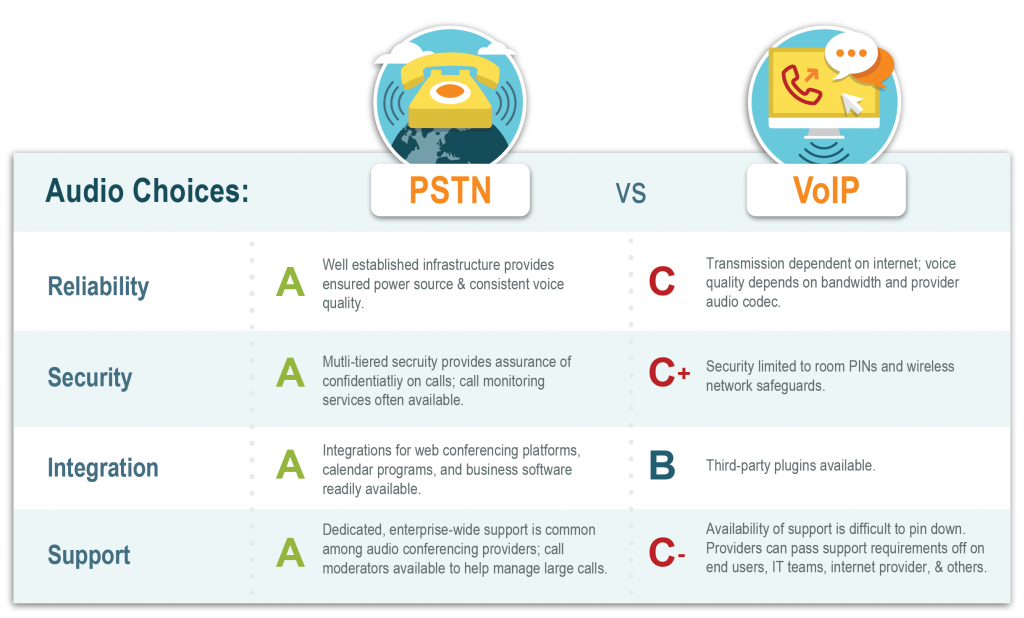Many businesses have wondered if they should switch from Public Switched Telephone Networks (PSTN) for cheaper Voice over Internet Protocol (VoIP) alternatives. And the PSTN vs VoIP debate will probably continue for some time.
If you’ve been tasked with looking into VoIP options, be aware that a change may have wide ranging impacts.
Many PSTN providers offer a more robust solution for conferencing. So, organizations that make thousands of conference calls each year may find it more desirable to stick with PSTN. Whereas companies that are looking to keep costs down may want to go with VoIP.

When discussing a switch, you need to consider what the priorities are for your business. Are call quality and reliability the most important factors, or is it affordability? These are just a few of the questions you should ask when looking at PSTN vs VoIP.
There are advantages for using PSTN or VoIP. That’s why we’ve prepared this blog to help you make the best decision for your business.
Looking at PSTN vs VoIP
PSTN
PSTN has come a long way and is known for built-in reliability, call quality, and security. Traditional conferencing sometimes gets a bad rep. But the simple fact is that many enterprises are opting to stick with this service because it ensures a connection is always available.
Let’s look at some of the reasons businesses are sticking with PSTN.
PSTN Infrastrucure
As noted above, many enterprises stick with PSTN even after looking into VoIP. Why is that?
It comes down to a matter of reliability. PSTN utilizes the telephone lines you drive past every day. Over the decades, millions of dollars have been put into these networks. It’s a solid infrastructure that doesn’t lose connections during internet outages. Thousands of CEOs around the country are confident in the reliability PSTN networks offer.
Reliable PSTN lines also ensure connections of the highest quality. Even if you have thousands on a call, the infrastructure can manage even the largest loads. The guarantee of great voice and audio will always keep businesses coming back.

Lastly, PSTN networks can be leveraged to bolster security during confidential calls. Companies that disclose sensitive info over the phone want the assurance their call is secure. In our evaluation of the market, PSTN providers tend to provide more in the way of security than do VoIP providers.
Speaking of PSTN providers, let’s look a little more into why they shape many decisions related to our discussion.
PSTN Providers
Intense competition over the last few decades has required PSTN providers be at the top of their game. This competition has also driven per-minute prices way down, making conferencing significantly cheaper than at previous times. Unfortunately, these rates do not compare with VoIP costs, which can be close to nothing on a per-minute basis. (And that’s the only big drawback of PSTN: Cost.)
Many providers can accommodate international calling and ensure reliability no matter where a call begins or terminates. Providers can also provide organizations unique local access numbers that make it easy for multinational teams to dial into without incurring additional costs.
PSTN integrations with web conferencing platforms provide excellent reliability during online sessions, and present users an option – telephones – they may be more comfortable and familiar with (than computer mics). Typically, you only get these integrations from PSTN providers.
While PSTN may be the older technology, it is still serves many business needs effectively.
VoIP
VoIP emerged as a legitimate conferencing alternative to PSTN in the mid 2000s. The simple fact is that VoIP is a highly affordable alternative to PSTN. Paying for business internet services basically covers the actual costs for VoIP. (Having VoIP dial-out to telephones is another matter…)
Let’s consider the benefits and limitations of VoIP.
Benefits of VoIP
VoIP is affordable – and beyond what was mentioned above. Because VoIP is based on Internet Protocol, the mics and speakers in a computer become sufficient substitutes for a traditional hand-held telephone. This eliminates expensive purchases, like enterprise-wide phone systems.
Being the default for web conferencing software, VoIP also eliminates the need for outside voice integrations. The larger benefit is the minimization of the number of services a business uses.
There are also cases where VoIP is more desirable when used with web conferencing events, such as webinars. This is because participants are not expected to contribute vocally during webinars. So, VoIP becomes a good alternative as attendees will just need to turn on their speakers to listen.
Limitations of VoIP
While VoIP is a great solution for some, it does have limitations that should be considered.
Being internet based, VoIP is dependent upon bandwidth. This has a few consequences. Lacking bandwidth can impact the the quality of voice over VoIP. A bad connection can result in lagging, glitchy audio that can ruin a call.
To deal with this, VoIP has been configured in different ways. Some configurations give preference to the “delivery” of data packets, which decreases bandwidth consumption in the long run. Unfortunately, these configurations tend to output a worse sound quality.
There are some configurations that focus on maintaining the audio clarity. Maybe you can see where this is going. Greater audio quality requires more bandwidth to be used. Compromise is inevitable with VoIP presently. Maybe one day a configuration will be developed to deliver flawless audio with minimal bandwidth usage. We’re just not there yet.

Bandwidth issues can also be problematic when trying to connect with people around the world. If their internet infrastructure is not as advanced as the USA’s, your call may be in jeopardy.
The limitations listed here are diminishing – slowly. As bandwidth capacities are increased, VoIP will become more viable.
Side-by-Side Comparison of PSTN vs VoIP:
We’ve outlined the basic differences between PSTN vs VoIP below. The comparison shows how the two options match up to meet certain audio needs.
Why not PSTN & VoIP?
While PSTN remains a better option for most businesses, VoIP continues to improve. But does it have to be PSTN vs VoIP?
Of course not! Especially when it comes to web conferencing events. The two can be used side-by-side for online events as needed.
Get the reliability of a phone and the ease of using the internet!
MeetingOne’s AudioOne Audio Conferencing makes use of both options for your business.
We make use of SIP Universal Voice that allows users to enjoy both during online events!
Uncertain as to why you would want both? Check our Audio Options Checklist! It outlines the value each communication option offers for online events.






